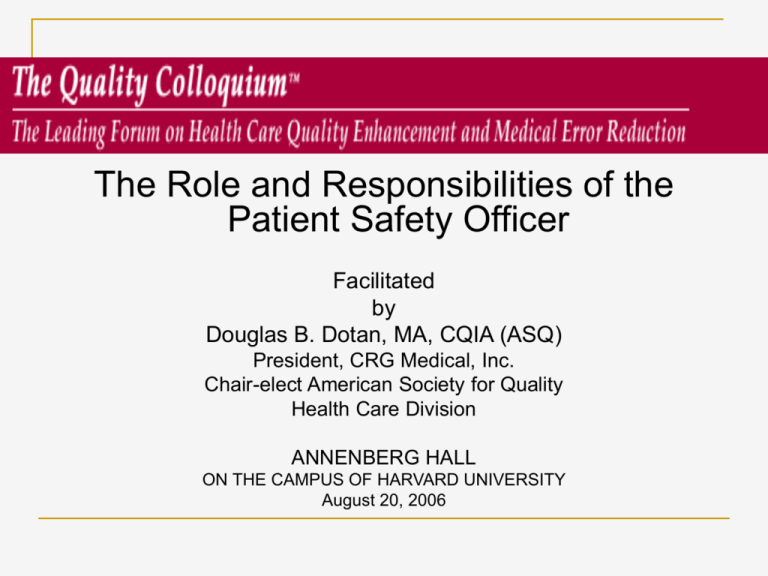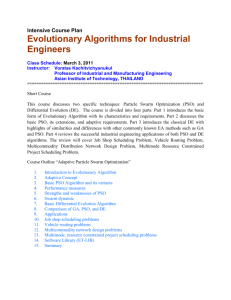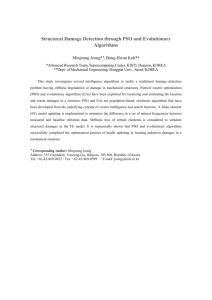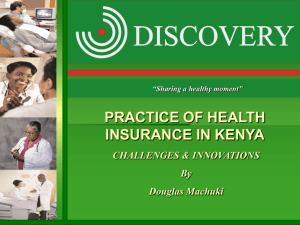Organization-wide Patient Safety Program
advertisement

The Role and Responsibilities of the Patient Safety Officer Facilitated by Douglas B. Dotan, MA, CQIA (ASQ) President, CRG Medical, Inc. Chair-elect American Society for Quality Health Care Division ANNENBERG HALL ON THE CAMPUS OF HARVARD UNIVERSITY August 20, 2006 Complacency Leads to Vulnerability “In flying, I have learned that carelessness and overconfidence are usually far more dangerous than deliberately accepted risks.” — Wilbur Wright in a letter to his father, September 1900 The 1902 Wright Glider executing a right turn. The 1905 Wright Flyer 3 in flight over Huffman Prairie near Dayton, Ohio. The crash of the Military Flyer in 1908. Learning Objectives of the Symposium Challenges Successful patient safety innovations Successful design and implementation of patient safety innovations Respective roles in stimulating and supporting patient safety improvement Practical program of patient safety officer training Healthcare quality and medical errors challenges facing American healthcare Agency of Healthcare and Research Quality – Dr. John Eisenberg “Music to my ears” “Translating Research Into Practice” TRIP was his mantra Our teaching hospitals receive millions of dollars every year in grants to conduct research Before the dollars run out – “publish or perish” … prepare to apply for the next grant Translating Research Into Practice What happens to that research? Was it time well spent? Was it money well spent? How many lives were saved by its use? What did it do to influence the delivery of safe quality care? Did this research contribute to the reduction waste in healthcare measured in billions of dollars each year? Research Grants How many in this room have worked on a research grant? How many of the grants you worked on were actually translated into practice at your facility? How many of these projects were used by other facilities? Public/Private Partnerships Researchers and their institutions jealously guard the outcome data that they justifiably want to publish Do not collaborate or partner with a private entity Public/private partnerships are a goal of AHRQ Make Value Out of Your Work Do you want your work to have value and make an impact on safe patient care? Do you want to reduce the unnecessary harm we inadvertently cause every day? You must seek out commercial partners, not only the government This will also help stop the waste of public money on redundant research projects AHRQ IT Conference in D.C. More than 15 home grown reporting system projects None of these are capable of communicating with each other All had exhausted their funding or would soon Many of them wanted to commercialize their work and were looking for funding They are designed as reporting systems that do not help prevent harm – who will invest? Learning Objectives of the Symposium Challenges Successful patient safety innovations Successful design and implementation of patient safety innovations Respective roles in stimulating and supporting patient safety improvement Practical program of patient safety officer training To share and discuss specific successful patient safety innovations that can be applied by healthcare organizations within fiscal constraints The Role and Responsibilities of the Patient Safety Officer The Myth of Sisyphus The PSO trying to implement change may sometimes feel like Sisyphus. Do you ever feel the gods had condemned you to ceaselessly rolling a rock to the top of a mountain, whence the stone would fall back of its own weight? What is your Role as a PSO? Role = Position = A Hat You Wear Responsibility responsibility - the social force that binds you to your obligations and the courses of action demanded by that force "every right implies a responsibility; every opportunity, an obligation; every possession, a duty"- John D. Rockefeller Jr. Survey Results The Role of the Patient Safety Officer 1. How long have you been a PSO? The range of experience in the room of those filling the role of patient safety officer varies from 4 weeks to 6 years. 2. What are your defined duties? 65% have RN backgrounds; 25% are MDs; 10% are a mix of Ph.D. Epidemiologists/Risk Managers/Performance Improvement/Quality Some of us today wear several hats. Role of the PSO Survey (Continued) 3. How many of your days a week are dedicated to PSO duties? 80% of the respondents were full time involved in patient safety responsibilities with varying differences 4. What primary discipline are you trained in? Did you receive formal training as a PSO? In regard to receiving training for the job of PSO 50% of the respondents have received or will be receiving training for their position. Role of the PSO Survey (Continued) 5. To whom do you report? Only 10% report to the CEO directly 30% to the CMO/Medical Director 10% CNO; and 50% to various VPs. 6. How Often? Only 10% responded that they report daily to their superior on patient safety activities – 90% reported weekly 7. Do you have a commitment and support from upper management? Team support did not exist for 30% of the respondents Role of the PSO Survey (Continued) 8. Do you have a team to support your position? Team support did not exist for 30% of the respondents – is that indicative of the people in the room today – are you on your own? 9. How do you receive information and disseminate the outcomes of analyzed data? Only 30% reported having some form of electronic tools to collect information and data from the care givers. Role of the PSO Survey (Continued) 10. What impact do you think your PSO position has had on the quality of the delivery of service to patients? The majority of respondents saw their roles as PSO as having raised awareness, made staff more responsive, and an increase in understanding 11. In what areas do you envision making changes? The areas where all the PSOs envisioned themselves making changes were specifically in communication and improved work processes\ The Investigation The order numbers, invoices and packing slips ALL say sand-filled bags The difference in contents is NOT readily apparent The sand and shot DO feel different if you palpate the bag The shot bags are a bit smaller but LOOK JUST LIKE the sand bags BOTH bags are made out of black vinyl NONE of the bags are labeled The bags are used to apply haemostatic pressure When preparing the bag for the patient it is picked up by the edges, placed on a towel, wrapped and placed on the patient It is standard practice to put pressure using a TOWEL WRAPPED SANDBAG on the site of the catheterization The patient required an EMERGENCY MRI after undergoing cardiac catheterization The MRI was started, the bag ‘moved’ towards the patient’s head, did not hit him and adhered to the machine The patient was removed from the machine with no harm Recommendations All “sandbags” are carefully examined to assure they indeed carry sand. Check your vendors to see there are no miscommunications about orders Remove all metal-shot bags at your facility and replace them with sand-filled ones February 5,2001 Item: Magnetic Resonance Imaging (MRI) systems, all. Specific Incident: A “sand bag” attached to a patient’s arm undergoing an MRI exam contained iron pellets (unknown to staff) encased in heavy vinyl; brand name “North West”. When the patient was being moved into the MRI bore, the iron-filled bag flew into the magnet and pinned the patient’s forearm to the side of the magnet. Emergency measures were used to turn the magnet off, and the patient was unharmed. Sometimes, “sand bags” = “iron bags” To better understand other potential hazards with MRI systems, please see the “Supplemental MRI Hazard Summary” on the NCPS Web site http://vaww.ncps.med.va.gov/. AND, please notify NCPS if your facility has had close calls, or you have discovered effective countermeasures. Also see FDA guidance at www.fda.gov/cdrh/ode/primerf6.html Source: John Gosbee, VHA Center for Patient Safety, 734-930-5890, John.Gosbee@med.va.gov 1) Purchase “sand bags” for patient care that do not contain iron (or only materials specified by the vendor to be used safely). These bags should be labeled MRI-safe (i.e., intended for use in your specific MRI environment) 2) If your facility continues to use “sand-bags” for patient care that contain iron, those bags should be clearly labeled “Contains Iron: DO NOT expose to MRI” 3) Patients should disrobe and wear clothing tested for your MRI environment 4) DO NOT verify that a “sand-bag” is compatible by testing it with the MRI magnet – this could have catastrophic consequences 5) Staff should consider all items to be unsafe for the MRI environment until “proven” otherwise. This could be done with a checklist, where each item is explicitly determined “safe” by manufacturer documentation and removal of any metal items Learning Objectives of the Symposium Challenges Successful patient safety innovations Successful design and implementation of patient safety innovations Respective roles in stimulating and supporting patient safety improvement Practical program of patient safety officer training To support strategies to successfully design and implement patient safety innovations in hospitals, health plans, medical groups and other healthcare settings First we created a Directorate for Quality Assurance and Flight Safety that reported directly to the Commander of the Air Force Air Safety Investigators were empowered by the CO to go anywhere, see anything and speak to anyone. design & implement patient safety innovations Conducting non-punitive safety investigations Disseminated the lessons learned to everyone involved in the operation of an aircraft Moved from investigating mishaps to investigating near-misses or close calls just like it happens in civil aviation today All final safety investigative reports were sent to the various ‘C’ Suite equivalents for comment on the recommendations which were based on the findings of the analysis We can learn from NASA NASA has a program to give back to the public sector the results of billions of dollars in research that went into the space program President John Kennedy presented to NASA a super-ordinate goal of “putting a man on the moon” Why can’t we make John Eisenberg’s vision “translating research into practice” or “making patients safe” be healthcare’s super-ordinate goal? The Super-ordinate Goal of Healthcare Why can we not have the hospital cleaning person, when asked “what do you do here” answer: “I am helping to keep patients safe” just like the janitor at the Kennedy Space Center answered Lyndon Johnson “I am helping to put a man on the moon”. Learning Objectives of the Symposium Challenges Successful patient safety innovations Successful design and implementation of patient safety innovations Respective roles in stimulating and supporting patient safety improvement Practical program of patient safety officer training To describe the respective roles of: government, accrediting bodies, the press, employers, technology and information systems, hospitals and health systems physicians and physician organizations pharmaceutical and device manufacturers patients and families in stimulating and supporting patient safety improvement “Ineffective communication is widely acknowledged to be at the root of the majority of patient safety issues and medical malpractice claims” Michael Woods, MD St. Vincent Regional Medical Center, Santa Fe, New Mexico The Six Factors of Communication Risk Determinants of Communication Effectiveness and Comprehension At least 36 variables can affect the communication outcomes between two individuals Humanism “….it seems we drift further away from humanism and the very real needs of the individuals we treat” “The patient safety movement sits precariously poised on the edge of the same logic driven chasm as the rest of medicine, obsessed by a nearly exclusive focus on defining processes as the key to enhancing safety” Michael Woods, MD The PSO’s Listening Catheter In one ear, out the other, and into the trash Patients and Families Solicit input and participation from patients and families to improve patent safety by: Talk to patients and families during nursing manager or administrative rounds Ask “What can we do to improve the care you received in this hospital?” Listen, take notes, report what you are told back to the proper person Use Patient Satisfaction Surveys – usually completed AFTER patient goes home (20% return rate). The Opportunity to make a Difference As a patient safety officer you have a unique opportunity to make a difference. The primary factor in most medical misadventures, mishaps, or close calls is the failure to communicate, or the failure to communicate well. That was one of the lessons that medicine is now learning from the aviation industry. We have today sessions on the lessons learned from the techniques utilized in aviation crew resource management and critical communications and crisis response improvement training. We will have a panel discussion of the role of team training in patient safety. What should the PSO demand What level of organizational reporting? What training? What kind of support? What kind of decision making process? What kind of data? What level of control – what departments report to the PSO? Learning Objectives of the Symposium Challenges Successful patient safety innovations Successful design and implementation of patient safety innovations Respective roles in stimulating and supporting patient safety improvement Practical program of patient safety officer training To implement a practical program of patient safety officer training 1. American Society for Quality (ASQ) Quality Institute for Healthcare (QIH) 2. IHI – Patient Safety Course 3. ABQURP – Train for Patient Safety 4. ASHRM – Patient Safety Training 5. MBNQA and State Quality Award Examiner Training Design for Patient Safety Design for Patient Safety Design a patient safety organization – not only appoint a Patient Safety Officer Build a Center for Patient Safety which is accountable to the hospital CEO directly Establish a patient safety culture from the bottom up in every unit of the hospital Educate, provide feedback, share knowledge and train practitioners in best practices Methodologies Measure and report the quality and effectiveness of care in the hospital, ambulatory and other care settings Improve patient communication and redesign care from the patient’s perspective Design safe hospitals based on human factors, usability and patient-centered care Integrate systems to capture, classify and analyze data creating institutional knowledge Harness Information Technology for rapid knowledge transfer and measurement and improvement of the delivery of health services The Explosion of Challenger The explosion of the 'Challenger,' after twenty-four consecutive successful shuttle flights, grounded all manned space missions by the U.S. for more than two years. The delay barely evoked comment ... But contrast the early history of aviation, when 31 of the first 40 pilots hired by the Post Office died in crashes within six years, with no suspension of service. — C. Owen Paepke The Mission of Columbia “The route to the target is more important than the target. We are going to go for the target, but we enjoy the route as well.” — Israeli Air Force Col. Ilan Ramon, to reporters on the eve of his Space Shuttle flight, 16 January 2003. STS 107 was lost on re-entry on 1 February 2003 Contact CRG Medical, Inc. Patient Protection, Quality and Risk Management Solutions www.crgmedical.com Douglas Dotan, President ddotan@crgmedical.com (713) 825-7900 Houston, Texas






